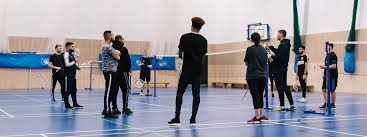The Role of a Physical Education (PE) Teacher
A Physical Education (PE) teacher plays a vital role in the development of students both physically and mentally. Their impact goes beyond teaching sports and fitness; they instil values of teamwork, discipline, and healthy living.
PE teachers design and deliver lessons that cater to students of all abilities, ensuring inclusivity and encouragement for everyone to participate. They not only focus on physical skills but also teach the importance of sportsmanship, fair play, and respect for others.
Through a variety of activities such as team sports, individual exercises, and fitness routines, PE teachers help students build strength, endurance, coordination, and confidence. They create a safe and supportive environment where students can challenge themselves and learn the value of perseverance.
Besides physical development, PE teachers promote mental well-being by emphasising the benefits of exercise on overall health. They educate students on the importance of staying active, making healthy choices, and managing stress through physical activity.
PE teachers serve as role models for their students, demonstrating dedication to fitness and leading by example. They inspire a lifelong love for movement and encourage students to adopt healthy habits that will benefit them long after they leave school.
In conclusion, the role of a PE teacher goes far beyond teaching sports skills; they shape young minds by promoting physical health, mental well-being, teamwork, and resilience. Their influence extends beyond the classroom to empower students to lead active and fulfilling lives.
8 Essential Tips for Effective PE Teaching: Fostering Engagement and Safety in Physical Education
- Ensure students warm up properly before engaging in physical activities.
- Provide clear instructions and demonstrations for each exercise or game.
- Encourage students to participate and try their best, regardless of their skill level.
- Promote teamwork and good sportsmanship among students during games and activities.
- Monitor students closely to ensure they are using proper form and techniques to prevent injuries.
- Incorporate a variety of activities to keep classes engaging and enjoyable for all students.
- Provide constructive feedback to help students improve their skills and performance.
- Create a positive and inclusive environment where all students feel comfortable participating.
Ensure students warm up properly before engaging in physical activities.
It is crucial for a PE teacher to ensure that students warm up properly before engaging in physical activities. A thorough warm-up not only helps prevent injuries but also prepares the body and mind for the exercise ahead. By incorporating dynamic stretches, light cardio, and mobility exercises into the warm-up routine, students can improve their flexibility, circulation, and overall performance during the activity. Encouraging students to take this essential step demonstrates a commitment to their well-being and sets a positive example for lifelong fitness habits.
Provide clear instructions and demonstrations for each exercise or game.
When it comes to being an effective PE teacher, providing clear instructions and demonstrations for each exercise or game is paramount. By clearly outlining the objectives, rules, and techniques involved in the activity, students can better understand what is expected of them and how to perform the task correctly. Demonstrating the exercise or game visually helps students grasp the concept more easily and allows them to replicate the movements accurately. Clear instructions and demonstrations not only enhance student learning but also promote a safe and engaging environment for physical education classes.
Encourage students to participate and try their best, regardless of their skill level.
Encouraging students to participate and give their best effort, regardless of their skill level, is a fundamental principle for a PE teacher. By creating an inclusive environment where every student feels valued and supported, the teacher can help instil confidence and motivation in each individual. It is through this encouragement that students can learn the importance of perseverance, teamwork, and personal growth, ultimately fostering a positive attitude towards physical activity and self-improvement.
Promote teamwork and good sportsmanship among students during games and activities.
Promoting teamwork and good sportsmanship among students during games and activities is a fundamental aspect of a PE teacher’s role. By encouraging collaboration, communication, and mutual respect on the field or court, PE teachers not only enhance the overall experience of physical education but also instil valuable life skills in their students. Emphasising the importance of working together towards a common goal and exhibiting fair play helps cultivate a positive and supportive environment where students learn to value teamwork and sportsmanship both in sports settings and beyond.
Monitor students closely to ensure they are using proper form and techniques to prevent injuries.
It is crucial for a Physical Education (PE) teacher to monitor students closely to ensure they are using proper form and techniques during physical activities. By keeping a watchful eye on their students, the PE teacher can help prevent injuries that may occur due to incorrect posture or movements. Correcting form and technique not only reduces the risk of injuries but also promotes effective skill development and overall physical well-being. Through attentive supervision, the PE teacher creates a safe environment where students can learn and participate in activities with confidence and proper guidance.
Incorporate a variety of activities to keep classes engaging and enjoyable for all students.
To enhance the learning experience and foster participation among students, PE teachers should incorporate a diverse range of activities in their classes. By offering a variety of exercises, sports, and fitness routines, teachers can cater to different interests and abilities, keeping the classes engaging and enjoyable for all students. This approach not only promotes physical development but also encourages teamwork, creativity, and a sense of accomplishment among learners. Overall, incorporating a variety of activities is key to creating a dynamic and inclusive PE environment that motivates students to stay active and embrace a healthy lifestyle.
Provide constructive feedback to help students improve their skills and performance.
One essential tip for a PE teacher is to provide constructive feedback to help students improve their skills and performance. By offering specific and actionable advice, teachers can guide students towards growth and development in their physical abilities. Constructive feedback not only highlights areas for improvement but also acknowledges achievements, fostering a positive learning environment where students feel motivated to strive for progress. Through effective feedback, PE teachers can empower students to set goals, work towards them, and ultimately enhance their skills and performance in various physical activities.
Create a positive and inclusive environment where all students feel comfortable participating.
Creating a positive and inclusive environment where all students feel comfortable participating is essential for a PE teacher. By fostering a welcoming atmosphere, PE teachers can encourage students to engage actively in physical activities, regardless of their skill level or background. This approach not only promotes teamwork and camaraderie but also boosts students’ confidence and motivation to stay active. When every student feels valued and supported, they are more likely to enjoy the benefits of physical education and develop a lifelong appreciation for fitness and well-being.

